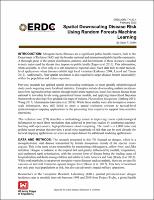Please use this identifier to cite or link to this item:
https://hdl.handle.net/11681/35618| Title: | Spatial downscaling disease risk using random forests machine learning |
| Authors: | Griffin, Sean P. |
| Keywords: | Mosquitoes as carriers of disease Diseases--Risk factors Dengue--Risk factors Geospatial data Epidemiology |
| Publisher: | Geospatial Research Laboratory (U.S.) Engineer Research and Development Center (U.S.) |
| Series/Report no.: | Technical Note (Engineer Research and Development Center (U.S.)) ; no. ERDC/GRL TN-20-1 |
| Abstract: | Mosquito-borne illnesses are a significant public health concern, both to the Department of Defense and the broader national and international public health community. A thorough grasp of the spatial distribution, patterns, and determinants of these diseases is needed to truly understand the threats they impose on public health. This information, when available, is often only at a sub-national to regional scale. Such data fails to meet tactical-level applications when diseases exhibit high local variation. Additionally, finer spatial resolution is also required to target disease burden successfully within the population and reduce exposure. Previous research has applied spatial downscaling techniques to meet specific epidemiological study needs requiring more localized statistics. Examples include downscaling malaria incidence rates from regional to urban centers through multivariate regression, hand-foot-mouth disease from national to township levels using generalized linear models, and applying hierarchical Bayesian frameworks to develop 5 km gridded risk maps of malaria, Plasmodium falciparum. While these studies were able to improve coarse-scale information, they still failed to meet a spatial resolution relevant to tactical-level epidemiological mapping applications or the processing time required to support time-sensitive operations. This technical note (TN) describes a methodology aimed at improving coarse epidemiological information to much finer resolutions than achieved in previous studies by combining machine-learning with open-source, high-performance cloud computing. The result is a 1,000 meter (m) gridded raster product that provides a pixel-wise magnitude of risk that can be used directly for tactical mapping applications or serve as an input dataset for additional modeling applications. |
| Description: | Technical Note |
| Gov't Doc #: | ERDC/GRL TN-20-1 |
| Rights: | Approved for Public Release; Distribution is Unlimited |
| URI: | https://hdl.handle.net/11681/35618 http://dx.doi.org/10.21079/11681/35618 |
| Appears in Collections: | Technical Note |
Files in This Item:
| File | Description | Size | Format | |
|---|---|---|---|---|
| ERDC-GRL TN-20-1.pdf | 835.72 kB | Adobe PDF |  View/Open |